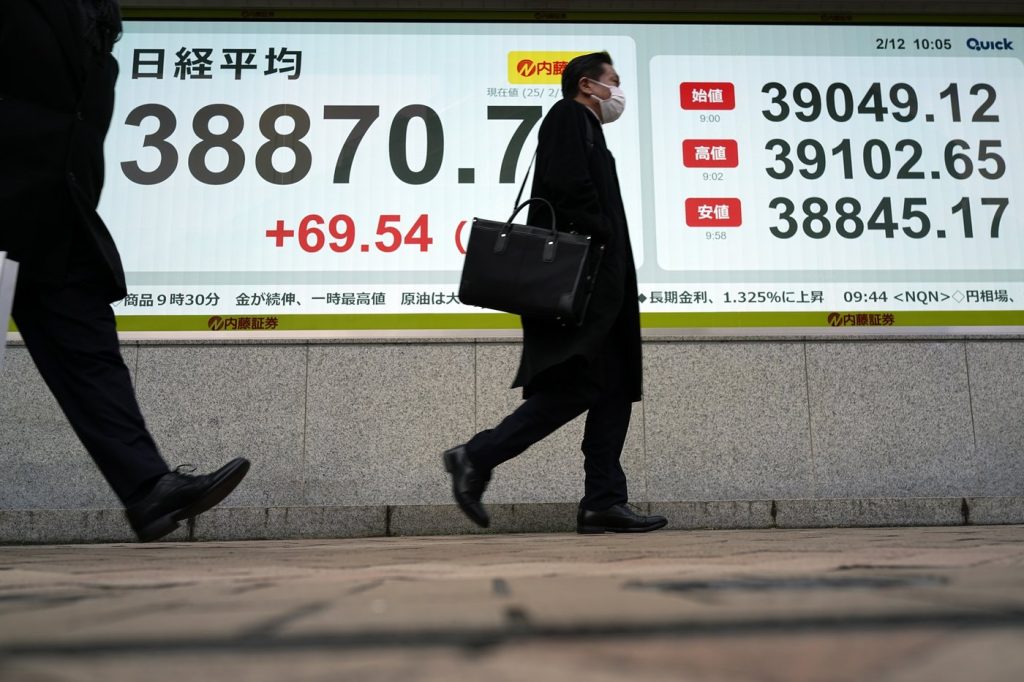TOKYO (AP) Asian shares experienced a mostly positive trend on Wednesday, with regional markets closely monitoring President Donald Trump's ongoing tariff escalations. Investors are currently grappling with uncertainty regarding the future implications of these policies, particularly following Trump's recent announcement of imposing 25% tariffs on foreign steel and aluminum imports into the U.S.
Countries such as South Korea, along with Japan to a lesser extent, are significant exporters of steel to the U.S. However, the potential impact on their economies may be limited as both nations export a wider array of goods. Last month, Trump initiated a 10% duty on all Chinese imports, further heightening concerns in the trading community.
In the day's trading, Japan's benchmark Nikkei 225 index increased by 0.2% to reach 38,864.96. Similarly, Australia’s S&P/ASX 200 saw a 0.4% gain to 8,519.40, while South Korea’s Kospi edged up by 0.3% to 2,546.41. Notably, Hong Kong's Hang Seng index surged by 1.6% to 21,626.80, spurred by excitement surrounding the tech firm DeepSeek, although investors are questioning when this rally might reach its peak. In contrast, the Shanghai Composite index dipped slightly by less than 0.1% to 3,317.83.
The movements on Wall Street reflected modest activity, not only in the stock markets but also in the bond sector where Treasury yields experienced only slight increases. The prospect of a trade war looms large, with high stakes involved. There's a broad consensus on Wall Street that ongoing and substantial tariffs could lead to increased prices for U.S. households and significant repercussions for global financial markets.
Trading conditions remained relatively calm, largely due to President Trump's history of retracting trade threats. This uncertainty signifies that tariffs may be employed as negotiating tools rather than fixed policies, providing some hope among investors that severe consequences might be avoided. Solita Marcelli, Chief Investment Officer for the Americas at UBS Global Wealth Management, suggested that the metal tariffs could be used strategically in negotiations.
Federal Reserve Chair Jerome Powell reiterated in his recent testimony that the Fed is not in a rush to further reduce interest rates. Following significant cuts to the main interest rate at the end of the previous year, aimed at bolstering the economy, concerns about persistent inflation have tempered expectations for additional rate cuts in 2025. Some market participants are beginning to speculate that no rate cuts may take place, primarily due to tariff-related worries.
Powell described the current state of the economy and interest rates as “in a pretty good place,” acknowledging the delicate balance required between avoiding excessive caution on rate cuts, which could harm economic growth, and acting too swiftly, which could exacerbate inflation. Elevated interest rates typically exert downward pressure on asset prices, complicating the investment landscape, especially when stock valuations appear stretched. The S&P 500 is currently close to its all-time high set in January.
To counterbalance potential pressures on stock prices from higher rates, companies are increasingly focusing on delivering robust profit results. This trend has been notably evident in recent earnings reports for large U.S. corporations. For instance, Coca-Cola's stock jumped by 4.7% after reporting stronger-than-expected profits and revenue, driven by growth in China, Brazil, and the United States. DuPont also saw a rise of 6.8% after exceeding Wall Street's profit anticipations.
Overall, the S&P 500 showed slight movement, rising 2.06 points, or less than 0.1%, to close at 6,068.50. The Dow Jones Industrial Average added 123.24 points, up 0.3% to finish at 44,593.65, while the Nasdaq composite faced a decline of 70.41 points, or 0.4%, closing at 19,643.86.
In the bond market, the yield on the 10-year Treasury increased to 4.53% from 4.50%, while the two-year Treasury yield remained stable at 4.28%. Energy markets experienced slight declines, with U.S. benchmark crude oil falling by 29 cents to $73.03 per barrel and Brent crude dipping 27 cents to $76.73.
On the currency front, the U.S. dollar strengthened to 153.64 Japanese yen, up from 152.43 yen, with the euro remaining unchanged at $1.0363.










